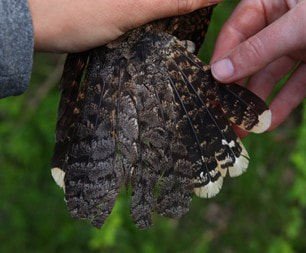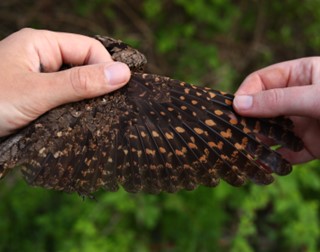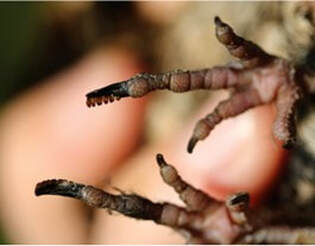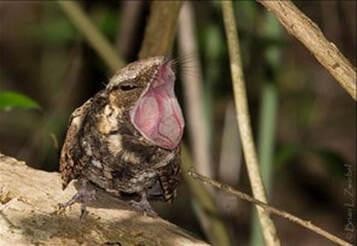Enjoying our blogs?Your support helps BSBO continue to develop and deliver educational content throughout the year.
|
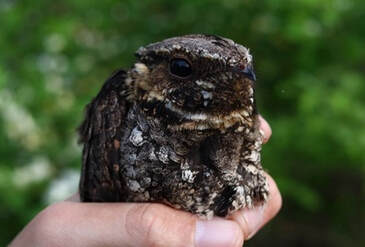 WHIP-poor-WILL, WHIP-poor-WILL! The Eastern Whip-poor-will (EWPW) is often heard but very rarely seen, which is why it was so exciting to catch one in the nets a few mornings ago! Whip-poor-wills are pretty widespread throughout the eastern United States, but their nocturnal habits and highly camouflaged feathers mean that most people can go their whole lives without ever seeing one. It’s even unusual to see one at the banding station; although we open the nets before sunrise, we’re often just a little too late for the whip-poor-wills. Our EWPW was easily identifiable as a female because of the smaller, buffy spots in her outer rectrices. A male would have had large white patches on either side of the tail. In addition to sexing the bird, we were also able to use several plumage characteristics to determine that our bird was an after-second-year, or ASY. One of these diagnostic features is that the rectrices and outer primaries were very broad and truncate instead of narrow and pointy. Another clue is that the primary coverts and outer greater coverts had distinct brown spots with dark edging instead of buff tipping/edging that would indicate a younger bird. EWPW are part of a family of birds known as nightjars, most of which are nocturnal, cryptic insectivores. One other relative, the Common Nighthawk, occurs in northwestern Ohio, but it can be quickly differentiated from EWPW by the presence of white wing patches that are very visible in flight. Like all nightjars, EWPW have large heads, rictal bristles (or “bristicles” as we like to call them), and very soft body plumage. They also have middle toes that are pectinate, meaning that they have little projections, like the teeth on a comb. These specialized toenails are used as grooming tools to brush feathers and rictal bristles. Another fun adaptation of EWPW is their deceptively tiny beaks. Because EWPW are strictly insectivorous, they don’t need very strong beaks. However, since they catch insects while flying, that dinky little beak opens up into a massive gape that allows them to easily gobble up fairly large bugs. Unfortunately, these fascinating birds are not nearly as numerous as they used to be. Habitat loss due to agriculture and urbanization and food source loss due to pesticides are major drivers of the population decline. Additionally, as a ground-nesting bird, EWPW are particularly vulnerable to predation, both from other wild animals and from outdoor cats and dogs. One easy thing that we can all do to help EWPW and other birds is to keep our cats inside. If you’d like to read more on the topic of cats or on what else you can do to support conservation, check out BSBO's Position of Feral and Free-ranging Cats and Easy Ways for YOU to Support Conservation.
0 Comments
Your comment will be posted after it is approved.
Leave a Reply. |
AuthorsRyan Jacob, Ashli Gorbet, Mark Shieldcastle ABOUT THE
|
